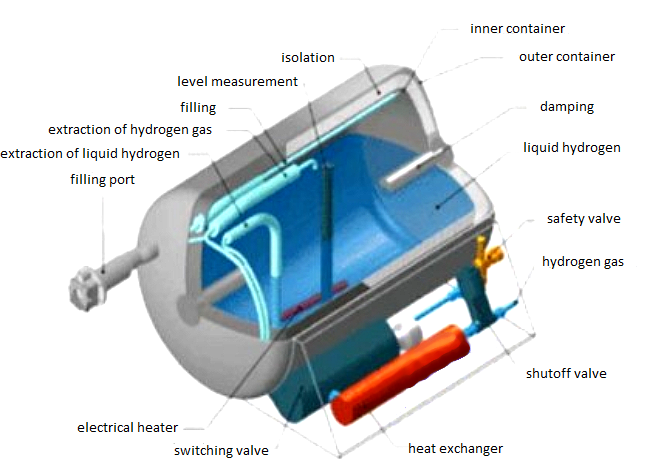CRYOGENIC LIQUID HYDROGEN STORAGE
Liquefying hydrogen increases its storage density; hence it is possible to store more energy than when stored as a gas. LH2 (liquid H2) is stored at the temperature of -253°C, and the main concern is the energy-intensive process of liquefying using 30% of energy sourced by burning liquid hydrogen. Another problem represents a 3% volume loss of stored hydrogen daily. Therefore, it is crucial to develop new methods of liquefying to decrease energy demands and increase the efficacy of the process.

The energy demands mainly lye in ortho-form (o-H2) to para-form (p-H2) conversion. Ortho-form is a hydrogen molecule where the atoms have spin symmetry and para-form molecules atoms have spin asymmetry. The p-H2 is more stable in lower temperatures and has a lower enthalpy. Due to this characteristic, heat is released during the conversion increasing the energy demand of the process. The other factor is the purity of the gas; all gases except helium need to be removed, especially CO2, CO, CH4 and O2. Oxygen concentration above 1 mg per kg can cause explosion.
LH2 is stored in multilayer containers with superior insulation properties equipped with overpressure protection. The overpressure protection releases the evaporated LH2 to avoid pressure build-up in the tank. Usual daily losses of LH2 are 3% of the volume per day. Sometimes, the evaporated LH2 is captured and stored in additional pressure cylinders.[1]
Comparison of conventional methods
The following table shows the comparison of weight and volume characteristics for a full fuel tank of a C-segment car with a 500 km range representing the equivalent of 6 kg H2 to 45 l of petrol.
Container type |
Container weight [kg] |
Container volume [l] |
|
Fuel tank |
55 |
45 |
|
Cryogenic tank |
100 |
180 |
|
Steel tank 350 bar |
360 |
290 |
|
Composite tank 350 bar |
120 |
290 |
|
Composite tank 450 bar |
130 |
230 |
|
Composite tank 700 bar |
140 |
200 |
A hydrogen-powered car with 500 km range would be equipped with almost four times larger and 2-3 times heavier fuel tank compared to a petrol-powered car (in case of steel tank up to 7 times heavier than fuel tank).
[1] DLOUHÝ, Petr a Luděk JANÍK. Skladování vodíku I. Česká vodíková technologická platforma[online]. 2007. Available at: http://www.hytep.cz/cz/vodik/informace-o-vodiku/transport-a-skladovanivodiku/ 495-skladovani-vodiku-i